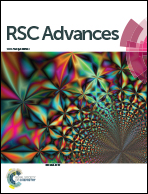Systematic development of novel cationic self-nanoemulsifying drug delivery systems of candesartan cilexetil with enhanced biopharmaceutical performance†
Abstract
The current studies entail systematic development, optimization and evaluation of cationic self-nanoemulsifying drug delivery systems (C-SNEDDS) for enhancing the oral bioavailability of candesartan cilexetil. Preformulation studies including equilibrium solubility studies and phase titration studies facilitated the selection of Lauroglycol 90 (i.e., lipid), Tween 40 (i.e., emulgent) and Transcutol HP (i.e., cosolvent), while oleylamine was used as a cationic charge inducer. D-optimal mixture design was employed for systematic optimization of C-SNEDDS, evaluating them for globule size, zeta potential, in vitro drug release and dissolution efficiency. Mathematical modeling was carried out and optimized formulation was identified through numerical optimization desirability function. Evaluation of the cellular uptake and permeability in Caco-2 cells revealed 2.2-fold increase in apparent permeability (Papp) and 6.4-fold reduction in the P-gp efflux ratio of the candesartan cilexetil from C-SNEDDS vis-à-vis the free drug solution. Nearly 5 to 6-fold enhancement in oral bioavailability was observed with the optimized C-SNEDDS vis-à-vis the plain SNEDDS and free drug solution using in situ single pass intestinal perfusion and in vivo pharmacokinetic studies, both conducted in Wistar rats. Establishment of various levels of in vitro/in vivo correlations (IVIVC) for the developed C-SNEDDS corroborated excellent goodness of fit between the in vitro drug release data with the in vivo absorption parameters. Evaluation of the cytotoxicity of C-SNEDDS by histopathological examination of rat intestine and MTT assay revealed high safety and efficacy of the developed formulations. Overall, the present studies report the successful development of novel C-SNEDDS of candesartan cilexetil with distinctly improved biopharmaceutical performance.


 Please wait while we load your content...
Please wait while we load your content...